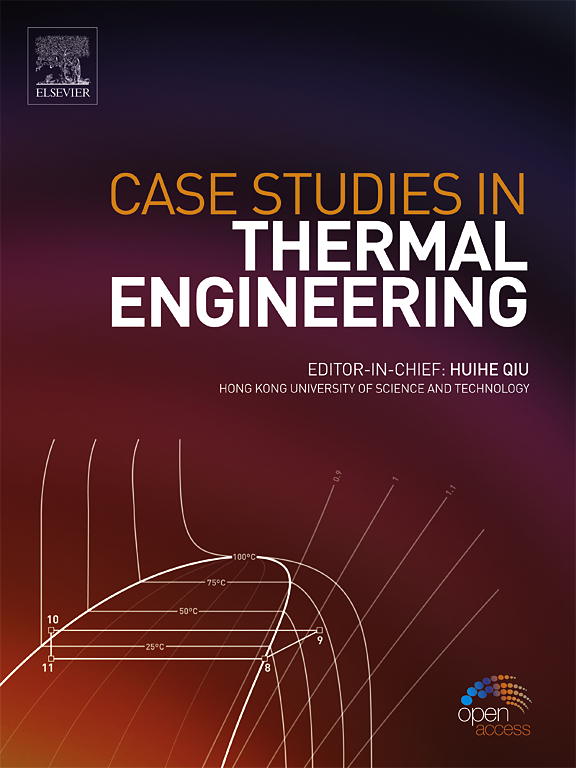Experimental evaluation of a high temperature cascade heat pump based on refrigerant charge
IF 6.4
2区 工程技术
Q1 THERMODYNAMICS
引用次数: 0
Abstract
Global energy demand continues rising with technological advancement. Renewables like solar and wind are increasingly adopted, yet heating/cooling systems responsible for 40 % of building energy use require urgent efficiency improvements. Heat pumps emerge as key solutions, particularly cascade systems. Refrigerant charge in cascade Heat pumps is critical: overcharging raises costs and leakage risks, while undercharging reduces heating capacity. To investigate the effect of refrigerant charge on the performance of the High-Temperature Cascade Heat Pump (HTCHP) system, a 20 kW HTCHP test rig was constructed. Several experiments were conducted to examine the variations in pressure, power input, heating capacity, and coefficient of performance (COP) with different refrigerant charge amounts in the Low-Temperature End Refrigeration Cycle (LS). An uncertainty analysis was performed to ensure the accuracy and reliability of the experimental results. The findings reveal that the evaporating and condensing pressures in both the LS and High-Temperature End Refrigeration Cycle (HS), as well as the power input of LS, heating capacity, and COP, increased with the refrigerant charge in LS. In contrast, the power input of HS showed little change. The HTCHP COP decreased by approximately 3.25 %–5.77 % as the refrigerant charge in LS increased by 300 g.基于制冷剂充注的高温叶栅热泵实验评价
随着技术的进步,全球能源需求持续增长。太阳能和风能等可再生能源越来越多地被采用,但占建筑能源消耗40%的供暖/制冷系统迫切需要提高效率。热泵成为关键的解决方案,特别是级联系统。级联热泵的制冷剂充注至关重要:充注过多会增加成本和泄漏风险,而充注不足则会降低供热能力。为了研究制冷剂充注量对高温梯级热泵(HTCHP)系统性能的影响,搭建了一台20 kW高温梯级热泵试验台。通过实验研究了低温末端制冷循环(LS)中不同制冷剂充注量对压力、功率输入、热容量和性能系数(COP)的影响。为保证实验结果的准确性和可靠性,进行了不确定度分析。结果表明:随着低温末端制冷循环中制冷剂充注量的增加,低温末端制冷循环和高温末端制冷循环的蒸发和冷凝压力、低温末端制冷循环的功率输入、制冷量和COP均增加;相比之下,HS的功率输入变化不大。当LS中制冷剂充注量增加300g时,HTCHP COP降低约3.25% ~ 5.77%。
本文章由计算机程序翻译,如有差异,请以英文原文为准。
求助全文
约1分钟内获得全文
求助全文
来源期刊

Case Studies in Thermal Engineering
Chemical Engineering-Fluid Flow and Transfer Processes
CiteScore
8.60
自引率
11.80%
发文量
812
审稿时长
76 days
期刊介绍:
Case Studies in Thermal Engineering provides a forum for the rapid publication of short, structured Case Studies in Thermal Engineering and related Short Communications. It provides an essential compendium of case studies for researchers and practitioners in the field of thermal engineering and others who are interested in aspects of thermal engineering cases that could affect other engineering processes. The journal not only publishes new and novel case studies, but also provides a forum for the publication of high quality descriptions of classic thermal engineering problems. The scope of the journal includes case studies of thermal engineering problems in components, devices and systems using existing experimental and numerical techniques in the areas of mechanical, aerospace, chemical, medical, thermal management for electronics, heat exchangers, regeneration, solar thermal energy, thermal storage, building energy conservation, and power generation. Case studies of thermal problems in other areas will also be considered.
 求助内容:
求助内容: 应助结果提醒方式:
应助结果提醒方式:


